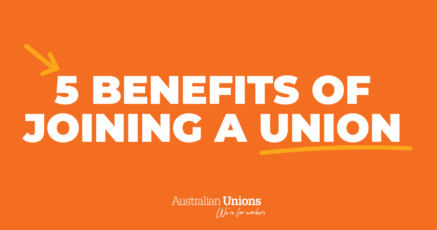Australians everywhere are contracting COVID-19 at staggering rates, and yet we continue to turn a blind eye to the unfair impacts on workers.
A recent report from the Australia Institute has found that a concerning number of people are showing up to work either symptomatic or after exposure to the virus. Their findings also suggest that the large majority of these people are young workers in insecure jobs.
Roughly three in ten workers aged 18-29 have come to work with COVID symptoms. Why? Because younger people are disproportionally represented in all forms of insecure work – whether it be casualisation, contract work, or ‘gig’ jobs.
COVID-19 and insecure work
It is sadly not surprising that those in insecure employment are more likely to come to work sick. In most forms of insecure employment, workers are entitled to little or no sick leave.
When every dollar counts, the onus has been unfairly placed on workers to determine whether they can forego their much-needed income in the interests of public health advice.
More than one in three workers are in a situation where they have no access to sick leave entitlements. Pandemic or no pandemic, this is unacceptable and puts workers’ health and safety at risk. Furthermore, over a quarter of young workers have turned up to work after being exposed to a potential case of COVID-19.
Because of insecure work, 37% of Aussies had NO statutory sick pay entitlement when COVID hit. Many others used theirs all up. This is a risk to health at the best of times; it’s a public health menace during a pandemic. New laws allowing more casual work will make it worse. /3 pic.twitter.com/P6jfxg68LU
— Centre for Future Work (@CntrFutureWork) May 17, 2022
The Australia Institute summarises the root of this problem:
“Millions of workers have either used up all the paid sick leave they are entitled to, or do not receive sick pay entitlements in the first place. There is no doubt this has contributed to the epidemic of people attending work with possible COVID symptoms.”
“With incomplete sick leave coverage, workers face a devil’s choice: between staying home to protect themselves, their colleagues and the public; or going to work regardless simply to make ends meet.”
Insecure employment is plaguing our workforce and the burden has been placed on workers. This is a reminder that it our employers’ responsibility to uphold a safe and healthy workplace environment – not ours.
What can you do if you have COVID symptoms at work?
If you’re sick, remember that you are not obligated to come to work. Regardless of whether your symptoms are COVID related or not, you are entitled to stop work if there’s an imminent risk to your health or safety.
Even if you’re working from home, you should still take sick days if you’re ill. You may not be infecting your co-workers, but your own personal health is still important.
With hybrid and remote working arrangements becoming more commons, you can learn more about your rights by reading our Working From Home Charter.
Unions play the biggest role in protecting the health and safety of all workers. If you’re stuck in a bind or are still feeling unsure, contact your union.






SHARE:
Why are we still showing up to work with COVID symptoms?